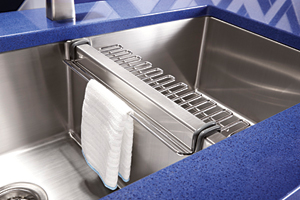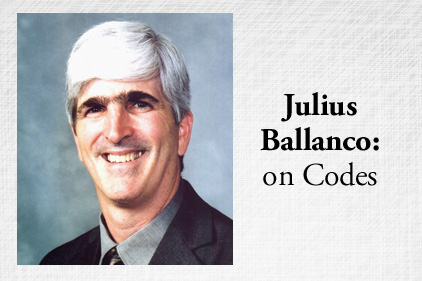
|
| Currently, the UPC requires a 1 ½-in. trap with a 2-in. trap arm for a kitchen sink. An attempt to lower the trap arm size to 1 1/2 in. was recommended for rejection. Photo courtesy of Kohler. |
When IAPMO switched in the 1990s to the consensus process for the development of the Uniform Plumbing Code, it knew it gave up some control of its document.
The consensus process typically works very well, with all changes based on technical merit. However, there can be abuse of the process. It is possible for a group serving on a consensus committee to control the outcome with limited technical justification. That is what occurred at a recent meeting of the IAPMO Plumbing Technical Committee in Salt Lake City.
I happen to serve on the TC representing the American Society of Plumbing Engineers. As such, I am directly involved in the discussion on all issues, as well as the voting.
The first two days of the meeting went rather smoothly by IAPMO standards. There was the usual bickering about various issues, but many quality code changes were recommended for approval. The biggest change to the code was the inclusion of all the standards in the body of the code. For years, there was a resistance to adding standards to the code. But a few cycles ago, the standards started to creep into various sections, such as the piping material sections.
This year, changes were proposed to add all remaining product standards to the code. Currently, these standards reside only in a laundry list in Chapter 14. The reference to the standards in the body of the code will make it easier for inspectors and engineers to use the code. There will be no guessing as to which standard applies.
Some of the early discussions related to reducing the flush volume and flow rates for certain fixtures. Individuals involved with the green code and conservation groups attempted to lower the water closet flush volume to 1.3 gpf (rounding up from 1.28 gpf) and the urinal flush volume to 0.5 gpf. Showers, kitchen sinks and lavatories also had proposals for lower flow rates. The new flush volumes and flow rates were similar to what is in IAPMO’s Green Code Supplement and what will become law in California next year. The argument against the lower flow rates and flush volumes was freedom of choice by the American public. All opponents thought the lower rates were good, but they shouldn’t be mandated.
The argument in support of the lower rates included water conservation, energy savings and wastewater treatment savings. It was pointed out that the population could increase without the need for major changes to infrastructure. Freedom of choice won out, with every change to lower the rates recommended for rejection.
Things get interesting
By the third day of the TC meeting, the consensus process was hijacked by the Friends of the UA. The UA is the United Association, also commonly known as the plumbers’ union. This was when the consensus process became a mixed blessing for IAPMO. The FUA decided to control the UPC, sometimes to the detriment of the IAPMO membership and staff. Of course, Day 3 was when all the meaty technical issues were being considered.
Everyone knew there would be trouble after an early morning change on plastic pipe. Believe it or not, there was a proposal to limit the use of plastic pipe to buildings two stories or less in height. For awhile, I thought I went back 30 years in a time machine. The initial motion was to reject the code change. That motion failed by one vote, with the FUA voting against it. The next motion was to accept. As many on the TC pointed out, adding such language would make the UPC unadoptable in almost every part of the country. There were some changes of heart and that motion failed. A repeat motion to reject followed and finally passed.
During a break after that code change, most anticipated a contentious day, with the FUA flexing its muscle. They were not disappointed. Some of the first technical changes in sanitary drainage dealt with pipe size.
There was an attempt to lower the trap arm size for a kitchen sink to 1 1/2 in. Currently, the UPC requires a 1 1/2-in. trap with a 2-in. trap arm. The FUA was opposed to lowering the size and stated that there was no technical justification.
In reference to the change indicated, when it was pointed out that based on the Manning equation, a 1 1/2-in. drain could handle more than twice the flow rate of the kitchen faucet, that still didn’t seem to matter. The change was recommended for rejection.
Also recommended for rejection was the change to remove the restriction on the number of water closets that can discharge to a 3-in. drain. The sizing would have been based only on fixture unit value. It didn’t seem to matter that the original limitations were based on 5.0-gpf water closets.
Consensus oddities
There was a change to add the drainage fixture unit value for non-water-supplied urinals to the sizing table. The proposed DFU value was listed as 0.5. No one on the TC commented that the value was inaccurately determined. The primary discussion was that the non-water-supplied urinals eventually will be removed because of quality issues. Therefore, you need a larger drain to accommodate the replacement of the urinal. This questionable mentality followed the same comments made on the previous day regarding a change to remove the need for a water supply for non-water-supplied urinals. As you probably guessed, these changes were recommended for rejection.
About 30 minutes after the discussion on drainage pipe size, there was a change to add a clean-out on the 2-in. trap arm of every kitchen sink. A few TC members commented about the need for this clean-out. One member noted he cleans the kitchen drain a number of times each year. Speaking louder than I thought and closer to the microphone than I realized, I said, “If it was a 1 1/2-in. trap arm, you wouldn’t have all the stoppages.” That elicited a bit of laughter.
One of the stranger proposed code changes was to mandate that a firefighter breathing air-replenishment system be installed in all high-rise buildings, underground buildings more than three stories below grade and tunnels. This is a proprietary system that allows a firefighter to refill his air tank without going back to the fire truck when fighting these fires. The first question one normally asks is, “Why is this proposed to the plumbing code?”
Someone came up with the idea that since it’s pipe, let’s put it in the plumbing code. The mandate of this system has been rejected by both NFPA and ICC, the logical location for such a code proposal. The FUA must have seen this as a labor-creating code change. The comical part of the proposal is that two former ICC staff members submitted the change and testified on the change. If you had a sinister mind, you would think they were adding it to the UPC to make the code less adoptable and, hence, the IPC more adoptable. The FUA was successful in getting this change recommended for approval.
Before you get too excited, realize this is the first step in a long consensus process. The results will be posted in the next two months as a report of proposals on the IAPMO website at www.iapmo.org. This is when the comment period begins. You will have an opportunity to review the changes and submit a comment to the TC for consideration at next year’s meeting. I would encourage you to download the ROP and consider submitting a comment.
Next month, I’ll include more on the UPC technical changes.



